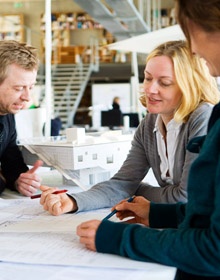Historier fra Center for ledelse i byggeriet
08. maj 2009
Innovative Technologies and Design Models for Sustainable Construction: Reemployment of Ideas and Practices from the Past
Søren Houen Schmidt
Tirsdag 19. maj gennemføres der på Center for ledelse i byggeriet en lukket forskningsworkshop, hvor 16 deltagere fra flere forskellige lande fokuserer på innovative teknologier og designmetoder, der kan hjælpe bæredygtighed på vej i byggeriet. Udover bæredygtighed er en væsentlig fællesnævner, at det sker ved at gentænke og genanvende ideer og praktiker fra fortiden. Her et klip fra introduktionen til workshoppen:
The current interest in environmental sustainability is increasing the demand for new technologies and architectural designs that facilitate the construction of environmentally sustainable buildings. The explicit aim is to construct buildings that consume low energy and ideally no energy at all.
Although this trend is global, there are remarkable differences in the kind of sustainability initiatives that are developing in different countries. For instance, solar cells are very advanced in France while enhanced and optimized insulation of the building envelope is becoming popular in Denmark. Another indication of national divergence is the production of zero energy houses, which has become more widespread in Austria and Germany than in Denmark. National divergence is attributable in part to national legislation that is being introduced and reinforced to encourage the construction of sustainable buildings. Some convergence is also taking place in response to the tightening of building codes across Europe. An interesting question is how and why sustainable construction is taking different expressions across Europe regardless of increasingly tight European building codes?
Deltagerne på workshoppen kommer fra flere forskellige europæiske lande, og sammen er de interesserede i hvordan idéer og praktiker fra fortiden bliver genanvendt som respons på, og i et forsøg på at skærpe, markedskravene for bæredygtigt byggeri.
Deltagerne arbejder fra forskellige teoretiske perspektiver for at sammenholde forskning og innovation inden for bæredygtigt byggeri på tværs af landegrænserne.
Workshoppen organiseres af adjunkt Eva Boxenbaum, Center for ledelse i byggeriet.
The current interest in environmental sustainability is increasing the demand for new technologies and architectural designs that facilitate the construction of environmentally sustainable buildings. The explicit aim is to construct buildings that consume low energy and ideally no energy at all.
Although this trend is global, there are remarkable differences in the kind of sustainability initiatives that are developing in different countries. For instance, solar cells are very advanced in France while enhanced and optimized insulation of the building envelope is becoming popular in Denmark. Another indication of national divergence is the production of zero energy houses, which has become more widespread in Austria and Germany than in Denmark. National divergence is attributable in part to national legislation that is being introduced and reinforced to encourage the construction of sustainable buildings. Some convergence is also taking place in response to the tightening of building codes across Europe. An interesting question is how and why sustainable construction is taking different expressions across Europe regardless of increasingly tight European building codes?
Deltagerne på workshoppen kommer fra flere forskellige europæiske lande, og sammen er de interesserede i hvordan idéer og praktiker fra fortiden bliver genanvendt som respons på, og i et forsøg på at skærpe, markedskravene for bæredygtigt byggeri.
Deltagerne arbejder fra forskellige teoretiske perspektiver for at sammenholde forskning og innovation inden for bæredygtigt byggeri på tværs af landegrænserne.
Workshoppen organiseres af adjunkt Eva Boxenbaum, Center for ledelse i byggeriet.










